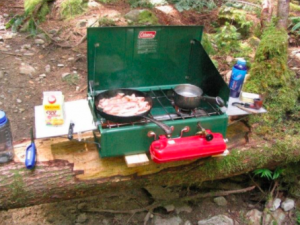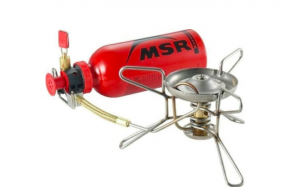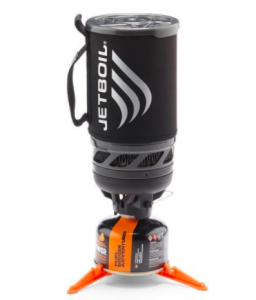If you plan to eat decently in the backcountry, stoves are a highly efficient solution to cook food while recreating outside. There are many types of stoves that can be used in an outdoor setting. Many of them are multipurpose, but some can be limited in their functionality due to their specific intended use. This article will act as a guide in helping you decide which type of backpacking stove is right for you.
Quick Navigation:
Camping Vs. Backpacking Stoves | Types of Backpacking Stoves | Key Considerations | Best Backpacking Stoves
Camping vs. Backpacking Stoves
Most outdoor stoves are categorized as either “camping” stoves or “backpacking” stoves. Sometimes two categories are combined, which can be slightly confusing. Camping stoves tend to be heavier duty double burner stoves that generally run on propane, like ones you might see from brands such as Coleman and Primus.
Backpacking stoves are small, light, collapsible one burner stoves that rely on liquid fuel or white gas. Due to their lightweight and packable design, these backpacking stoves are perfect for transporting in any type of pack. Now that the basic differences between camping and backpacking stoves are understood, we can dive a bit deeper into the different kinds of backpacking stoves.

Cooking on a Coleman Two Burner Stove
Types of Backpacking Stoves
Canister Stoves – These small lightweight stoves are easy to use, and they require little maintenance. What makes these stoves so great is their ability to unfold from a compact state, and then easily screw onto the fuel canister (isobutene and propane) for setup.
Pros: Small, lightweight, easy to light, flame can simmer on most models, no leaks when unscrewing stove from fuel canister, some models have pressure regulators which help with performance in cold weather and high elevation.
Cons: Not easy to recycle, wasteful, not easy to tell how much fuel is left, not very compatible with large pots and pans (usually require some human support while cooking), cold weather and elevation will usually give out a small weak flame (unless it specifically performs under those conditions), can be slightly more expensive than liquid fuel stoves.
Liquid Fuel Stoves – These stoves are probably the most versatile stoves on the market. Due to the use of refillable bottles, there is no canister to throw away making them leave a more sustainable impact on the environment. Liquid fuel stoves mainly run off of white gas which burns with a pure high power efficient flame. If there you find yourself traveling, maybe internationally, and the area does not have white gas, these stoves can run on other types of fuel too.
Pros: These stoves are great for traveling internationally, they perform well at elevation and in below freezing temperatures, cost of fuel per ounce is less than the price of the canister stove fuel, great for cooking on uneven surfaces, and they work well cooking for large groups.
Cons: They can be heavy, noisy, require priming the stove, periodic maintenance, fuel spills are possible, and cost of stove is bit higher than a canister stove
Alternative Fuel Stoves – There are other types of stoves that rely on various forms of fuel. There are portable wood-burning stoves, denaturized alcohol stoves, and solid-fuel tablet stoves. If you are planning a long-distance hike, or you are an ultralight hiker, these stoves work great for those applications. They also work great to be used in an emergency.
Pros: No need to carry fuel for wood stoves due to relying on leaves and twigs laying on the ground. Some stoves are simple, lightweight, and very cheap. They may generate enough electricity to help charge small electronics. Some of these stoves require little to no maintenance.
Cons: Often slower boil times than canister and liquid fuel stoves, sometimes by minutes. These stoves are intended primarily for boiling water. Wood-burning stoves may have restrictions on use during fire season, and finding dry wood to burn in a wet spot might be challenging. Some fuel sources like denatured alcohol may be hard to find internationally. Wind might pose a threat to some of these stoves, so it is often best to travel with a windscreen.
Considerations When Choosing a Backpacking Stove
Cook vs. Boil
While out in the wilderness, sometimes the goal is to slow down, and really enjoy your time outside. This may mean many slow days out in the field, where are willing to pack a few more pounds in your pack with real quality ingredients for meals you cook on the spot. If this is the case for you, a liquid fuel MSR Whisperlite stove would be a solid choice. These stoves are awesome due to their reliability in any weather, their compatibility for cooking with pans that need to simmer at varying temperatures, and some of the models like the Whisperlite Universal can take most types of liquid fuel instead of being limited to one fuel source.
In some sports, it is beneficial to be light and fast. Sports like ultralight backpacking, backcountry skiing, bikepacking, and mountaineering/alpine climbing thrive on lightweight equipment. If you fall into this light and fast category, a canister stove such as the Jetboil Flash Cooking System, or MSR Pocket Rocket would be a great choice. Both of these models are great for those people that are just looking to boil water for their dehydrated meals and make coffee. They are light, with fast boil times, and some of the integrated stove systems (stove systems that come with a stove, cooking vessel, and fuel canister) come with a wind screen to help cook more efficiently in windy areas you might find yourself in. With all of that being said, if you are planning on traveling as a big group, it would be wiser to bulk ration/meal plan and use a regular stove like the MSR Whisperlite.
Cooking Climate
Not all climates are created equal for cooking. When traveling in different environments, there are a few factors that change the quality of your cooking experience. The first factor is temperature. All stoves work perfectly fine in normal livable climates. However, once the temperatures start to drop below freezing, a canister stove’s fuel will likely condense and freeze up while cooking. At that point in time, you will be looking at your dehydrated meal in the cold and be very sad since you won’t be eating that night! This is a very good reason to invest in a liquid fuel stove if you plan on camping in cold temperatures. Unlike a single use fuel canister stove, a liquid fuel stove is also more sustainable since you are able to refill the fuel bottle over and over again.
Another factor when considering climates is altitude. Some stoves decrease in overall performance when boiling water or cooking at higher altitudes. Due to pressure decreasing at higher altitudes, longer boil, soaking, and cooking times might be required to fully enjoy your meal. Atmospheric pressure drops about a half pound for every one thousand feet gained in elevation. The boiling point of water will also decrease by about two degrees Fahrenheit per thousand feet of elevation gained. This means that your water will boil faster, but your food will probably still be rock solid. So a few extra minutes of soaking will be required until you can feast like there’s no tomorrow. The MSR Reactor is one of the few integrated canister stoves that is excellent for cooking at high altitude. Many alpinists will choose this stove due to its high power output, the built in windscreen, and its lightweight build.
11 Best Backpacking Stoves of 2023
- JetBoil Flash – This stove is great for heating up dehydrated meals and boiling water.
- MSR Pocket Rocket 2 – A great little stove that is inexpensive and functional.
- MSR Windburner – This is a windproof personal stove perfect for solo travel.
- Solo Stove Lite – An ultralight wood-burning backpacking stove.
- MSR Whisperlite Universal – A hybrid fuel stove great for all weather and simmering.
- Jetboil MightyMo – A wide pot design with great fuel efficiency and can simmer.
- Snow Peak LiteMax –Japanese titanium makes this one of lightest canister stoves.
- Esbit Solid – Lightweight solid fuel stove option for cooking simple meals.
- MSR Reactor – Works in any condition, high fuel efficiency, and fastest boil time.
- JetBoil MiniMo – Ideal for backpackers and climbers relying on dehydrated meals.
- JetBoil MicroMo – Ideal for backpackers looking to cook for 1 or 2.
If you’d like to purchase any of the above not on Amazon, please use the links below to support us:
MSR | Backcountry | REI
Summary
By looking closely at several types of stoves, it is pretty apparent that each has their own niche market for outdoor adventurers. The stoves listed here are well regarded industry leading stoves that recreationalists and professional adventure athletes use on a daily basis. It is important to give strong consideration to all of the various types of activities that the stove will be used for before purchasing a specific product. It is never fun for a trip and then realizing you don’t have the right equipment for your journey. So, be sure to look to all your options, consult your local gear shop or favorite gear guru, and then go out into the wilderness to cook up some fun!
Alex is a skier, climber, biker, paddler, paraglider pilot, and all-round adventurer. Originally from Woodstock, NY, Alex began skiing at 5 years old. The Catskill Mountains and Hudson Valley of upstate New York helped set the stage for Alex to fall in love with outdoor recreation. With an affinity to the outdoors, Alex sought out Lyndon State College (now called Northern Vermont University) where he studied Mountain Recreation Management. His concentration was in Ski Resort Management, but he also took several classes including climbing, kayaking, avalanche education, and group facilitation that were part of the Adventure Leadership concentration. While in school, Alex managed to ski most of the resorts in the New England, and explored much of the backcountry ski potential of the Green and White Mountains. As a recreation professional, Alex spent several seasons on ski patrol at Burke Mountain Resort, VT, and at Mission Ridge, WA. He has also guided backcountry ski trips to the Chic-Choc Mountains in Quebec, guided sea kayak tours and glacier hikes in Seward, AK, and has guided various backpacking trips in the Northeast. Alex now writes about his adventures, and is furthering his career to become an avalanche safety educator, as well as a fully certified AMGA Ski Guide.

![Choosing the Best Backpacking Stoves in 2020 [Complete Guide] Choosing the Best Backpacking Stoves in 2020 [Complete Guide]](https://hikingandfishing.com/wp-content/uploads/2020/06/Backpacking-Stoves.jpg)

